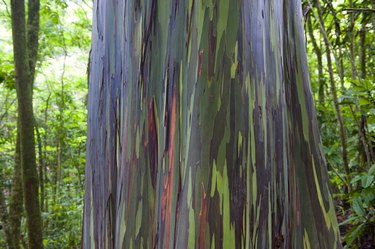
You've probably seen photos of cute koala bears snacking on eucalyptus leaves or inhaled the pungent scent of eucalyptus in dried flower arrangements and potpourri. This large genus of evergreen trees and shrubs, a member of the myrtle family, includes many sizes, scents and growth habits. Eucalyptus grows in U.S. Department of Agriculture plant hardiness zones 7 through 11, depending on species. Many species produce scented, lance-shaped or silver-dollar-shaped foliage. Eucalyptus trees can contract a variety of diseases and infections you'll want to prevent or treat immediately.
Pruning to Treat Diseases
Video of the Day
Some diseases, like the anthracnose fungus and leaf spot diseases, do not respond to chemical treatments, according to the University of California Integrated Pest Management Program. Anthracnose causes new growth to come in deformed or stunted. As the name implies, leaf spot produces small to large irregular or round spots or patches on the eucalyptus foliage. Several types of fungi cause leaf spot diseases, but the tree can usually recover on its own with judicious pruning. You need to take a multifaceted approach to treat canker diseases that form small to large, sometimes weepy, lesions on branches. Pruning is often the first step in returning a sick tree to health. Dead or dying areas may be pruned at any time, but if possible, delay pruning until fall and winter, when the eucalyptus tree is dormant.
Video of the Day
Biological Treatment
Bacillus subtilis is a strain of bacteria often used to kill stem blight, which causes leaf tips and edges to turn brown, forms lesions that distort the leaves and can produce cankers on woody areas of the tree. You can also use Bacillus subtilis to treat powdery mildew, which causes the eucalyptus foliage and twigs to look as if they've been sprinkled with baby powder. Some fungicides containing Bacillus subtilis are labeled for use on plants infected with anthracnose, which may limit that disease's ability to spread. When used before the tree develops a disease, Bacillus subtilis fungicides can help protect the eucalyptus from infection. Mix 1/4 cup of concentrated fungicide to 1 gallon of water. Fill a handheld or pump sprayer with the mixture and, wearing gloves and eye protection, spray the top and bottom of all eucalyptus foliage until the fungicide drips from the leaves. Keep children and pets away until the area dries. Repeat weekly as needed.
Chemical Treatment
You can use multipurpose fungicides to protect or treat your eucalyptus too. Leaf spot, anthracnose, powdery mildew and cankers may be treated with multipurpose fungicide. Mix 1 ounce of concentrate in 1 gallon of water, and spray the eucalyptus to the point of dripping, being sure to coat both the tops and bottoms of the leaves. Because many fungal infections arise after extended periods of rain or humid, cool weather, apply preventive treatments in time to protect the tree when heavy rain is predicted in your area. You can repeat applications every two weeks. Wear gloves, eye protection and protective clothing when spraying any chemical, and keep children and pets away from the treated area until it dries.
Cultural Controls
Keep the area around the eucalyptus free of weeds and plant debris that can harbor diseases. Eucalyptus trees do not normally require supplemental water beyond what nature provides, except during droughts. If you need to water the tree, water at ground level and do not get the foliage or trunk wet. The exception to this is when the tree suffers from powdery mildew infection. Spraying the leaves with water can wash off many of the powdery mildew spores, killing them. Prune as needed to improve sunlight and air penetration.
Keep It Clean
Disinfect your pruning tools by dipping them in a solution of 1 part laundry bleach to 3 parts water. Let the blades dry before cutting, and disinfect the tools again between each cut. Make slanted cuts on branches to allow rainwater to drain quickly. Cut close to the eucalyptus trunk but not against the trunk. Prune out infected areas and immediately remove all cuttings and plant debris from around the eucalyptus tree. Dispose of this material away from the yard.